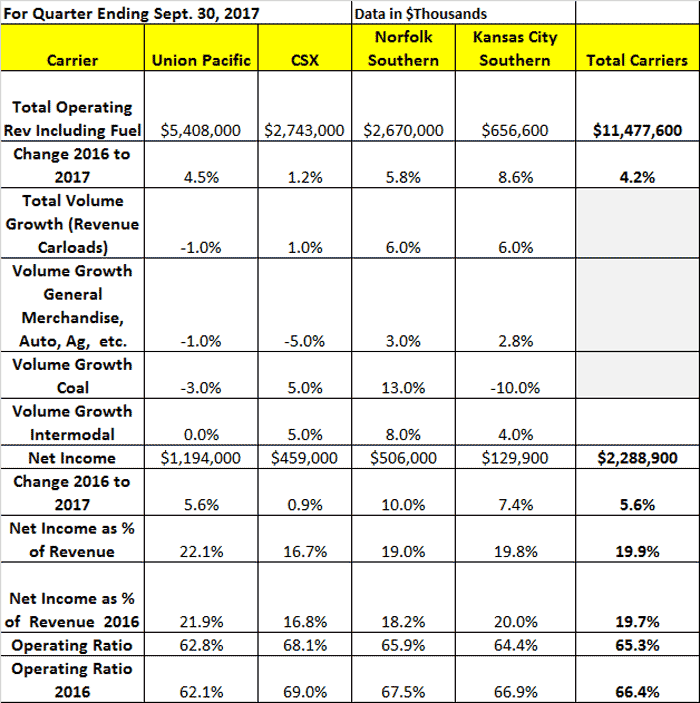US Rail carriers saw decent profit gains in Q3, despite very modest volume gains driven by two major Hurricanes in September.
We're back as usual every quarter with our review of the results and trends across freight modes, starting last week with US truckload carriers (see Strange Q3 for Truckload Carriers, as Market Strong, Profits Down).
Supply Chain Digest Says... |
 |
| CSX said that with "the implementation of Precision Scheduled Railroading, we remain on track to achieve record efficiency gains." |
 |
What do you say? |
| Click here to send us your comments |
 |
| Click here to see reader feedback |
|
|
This week, we look at the rail transport sector, and then next week we'll review results and trends in the less-than-truckload group.
As part of that review we look at the four major Class I public carriers that make up the US rail sector (Burlington Northern is of course part of public company Berkshire Hathaway, but its results are not broken out in any detail and thus are not included).
Carload volumes in our group were about flat at Union Pacific and CSX, but up 6% at both Norfolk Southern and Kansas City Southern. The big gains in coal volumes seen by most in Q2 mostly disappeared in Q3, with the exception of Norfolk Southern, which saw coal railcars up 13%.
According to the Association of American Railroads, total US carload traffic for the first nine months of 2017 was up 3.6%, with traditional car loads rising 3.8% and intermodal units up 3.5%.
The Cass Intermodal Price Index was up 0.6%,
1.3%. and
4.0% in July, August and September, respectively.
The big news in the quarter was that the extreme service issues seen in Q1 and Q2 at CSX related to new CEO Hunter Harrison's "Precision Scheduled Railroading" initiative appear to be largely gone.
What's more, CSX said the initiative drove efficiency gains of $95 million in Q3, with a lot more to come.
Profits for our group in Q2 were up a decent 5.6% in the quarter, though well down from the growth in Q2. Net income as a percent of sales was 19.9%, up just a bit from 19.7% last year, in numbers that compare favorably with almost any industry. By way of comparison, the same measure in Q3 was 17.1% at Procter & Gamble, and 7.9% at UPS. Union Pacific as usual led the way in the group, with a net profit margin of 22.1%.
That of course meant average operating ratios (OR), or operating expense divided by operating revenue, a key metric in the transport sector, were strong, at 65.3% (unweighted average) down from the 66.4% in Q3 2016, though up a bit from Q2. That level of OR is of course far superior to that seen in the truckload or LTL sectors, which generally see ORs in the high 80 percent levels and low 90 levels, respectively.
Q3 2017 US Rail Carrier Results

Source: SCDigest Analysis from Company Earnings Releases
(See More Below)
|
CATEGORY SPONSOR: SOFTEON |
|
|
| |
|
|
As usual, highlights of the comments from each carrier in their earnings releases are provided below, most of which even more brief than usual this quarer.
Union Pacific
Company said that quarterly freight revenue improved 4% compared to the third quarter 2016, as increased fuel surcharge revenue, core pricing gains and positive mix of traffic all contributed to the increase.
Core pricing was up a modest 2%, as that number continues to fall for the industry versus just a few years ago.
CSX
"The company’s results for the third quarter reflect the resiliency of Precision Scheduled Railroading, even during times of transition," said Hunter Harrison, president and chief executive officer. "With that transition largely behind us, we are now intensely focused on driving superior service for our customers and lasting value for our shareholders."
Company said it drove efficiency gains of $95 million in Q3.
Says that with "the implementation of Precision Scheduled Railroading, we remain on track to achieve record efficiency gains."
Norfolk Southern
Operating ratio of 65.9% was an all-time low, which made it seven straight quarters of an improving OR.
Revenue was up 6% and expenses up just 3% in the quarter.
Kansas City Southern
Company reported a record third quarter operating ratio of 64.4%, a 2.5 point improvement over third quarter 2016.
"KCS’ third quarter financial results were strong, even with the impact of Hurricane Harvey on KCS’ U.S. Gulf Coast and cross-border traffic in August and September," asaid CEO Patrick Ottensmeyer. "Despite the severity of the storm and widespread flooding, we recovered quickly from the extended service outage, delivering record third quarter operating income, operating ratio and adjusted earnings per share."
Any reaction to the Q3 review of the rail sector? Let us know your thoughts at the Feedback section below.
Your Comments/Feedback
|